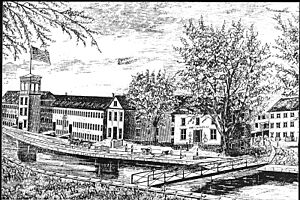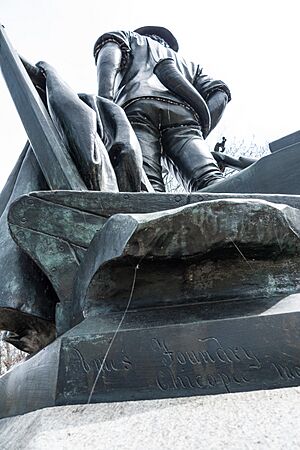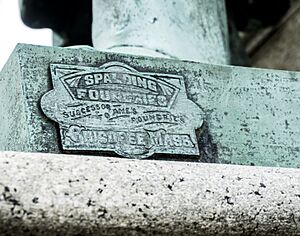Ames Manufacturing Company facts for kids
Quick facts for kids |
|
|
Ames Manufacturing Company
|
|

The former Ames factory in Chicopee, MA, now The Apartments at Ames Privilege
|
|
| Location | Chicopee, Massachusetts |
|---|---|
| Built | 1847 |
| Architect | Charles McClallan |
| Architectural style | Early Republic, Greek Revival |
| NRHP reference No. | 83000734 |
| Added to NRHP | June 23, 1983 |
The Ames Manufacturing Company was a very important factory located in Chicopee, Massachusetts. They were known for making many different items. These included swords, tools, and cutlery (like knives and forks).
The company also had a special part called an iron and bronze foundry. A foundry is a place where metal is melted and poured into molds to create shapes. Ames Manufacturing made many weapons for the Union Army during the American Civil War. These included side arms, swords, and cannons. They also created beautiful bronze statues that you can still see today.
Contents
Company History
The story of the Ames Manufacturing Company began a long time ago. The Ames family first started a factory in 1774 in Chelmsford, Massachusetts.
Later, in 1829, two brothers, Nathan P. Ames, Jr. and James T. Ames, moved their business. They made tools and cutlery. They moved to a new industrial town on the Chicopee River near Springfield, Massachusetts. A man named Edmund Dwight, who owned textile mills nearby, invited them. Soon, the Ames company started making swords for the government and state armies.
When the town of Chicopee was officially formed in 1848, the Ames brothers were important leaders there. After Nathan P. Ames passed away in 1847, his younger brother, James Tyler Ames, took over the company.
What They Made
Swords and Statues
By 1835, the company was working with brass and bronze. In 1845, they added an iron foundry. This meant they could melt and shape iron too. They used these foundries to create amazing statues. They also made military cannons and cannonballs.
Some famous works cast at the Ames company include the bronze doors of the East Wing of the United States Capitol. They also cast Daniel Chester French's famous Minuteman statue. This statue stands at the Lexington-Concord bridge.
Other large statues they made include:
- Two large horse statues of George Washington. One is in the Boston Public Garden and another in Washington, D.C..
- A statue of Benjamin Franklin in Boston.
- A statue of Major John Mason.
Helping in Wars
When the Mexican War happened, the factory mostly made weapons. This showed how important they were for the country's defense.
Later, during the American Civil War, the southern states left the Union. This meant the Union lost access to its weapon factories in the South. So, companies like Ames Manufacturing became very important. They were crucial for supplying the Union army. Ames was one of the most important makers of swords and light cannons. They were also the third largest producer of heavy cannons for the Union.
After the Wars
For many years, Ames Manufacturing made military equipment. This included swords, cannons, and cannonballs. But after the Civil War, they started making other things too. This is called "diversification." They made parts for sewing machines and even bicycles in the late 1800s. They were a big supplier of bicycle parts for the Overman Wheel Company from 1883 to 1887.
In 1881, the part of the company that made swords became its own separate business.
By 1907, the Ames foundries were bought by the A.G. Spalding Company from Chicopee. Spalding is famous for making sports equipment.
The Old Factory Today
The historic Ames Company factory is located at 5-7 Springfield Street in Chicopee, Massachusetts. It is a group of connected industrial buildings. The oldest parts of the factory were built in 1847. Most of the older buildings are made of brick. They range from one to four stories tall.
This factory complex was added to the National Register of Historic Places in 1983. This means it is recognized as an important historical site. The largest of these old buildings have now been turned into homes.






